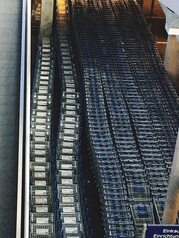Connectivity and Urban Development: Elevating Real Estate Value

Connectivity is a fundamental pillar in urban development, directly impacting the real estate value of a region. In an increasingly interconnected world, accessibility to transportation infrastructure and services not only improves quality of life but also raises the value of properties. In this article, we will explore how good connectivity can transform entire neighborhoods and make your investments more profitable. Join us to discover the true potential of your home!
The importance of road infrastructure in urban growth
Road infrastructure is an essential component for urban growth, as it facilitates the mobility of people and goods, thereby promoting the economic and social development of a region. An efficient and well-designed road system not only reduces travel times but also connects residential areas with commercial, educational, and basic service centers. This connectivity significantly improves the quality of life for residents by allowing them to access more job and recreational opportunities, which in turn attracts new residents and investors.
Furthermore, the quality of road infrastructure directly impacts property value. Properties located in areas with good road connections tend to experience an increase in their appreciation due to the high demand generated by their accessibility. Investing in developments situated near major roads or public transport projects can be highly profitable, as these features become determining factors for future buyers or tenants. In summary, proper planning and maintenance of road infrastructure are essential for creating prosperous and sustainable urban environments that benefit both their residents and the local real estate market.
2. How public transport influences property valuation
Public transportation plays a crucial role in the valuation of real estate, as its presence can radically transform the dynamics of a neighborhood. Areas well-connected through subway systems, buses, or trams tend to be more attractive to buyers and renters. This is because good accessibility reduces travel time and enhances quality of life, which in turn generates an increase in demand for local properties. Real estate developers are aware of this phenomenon and frequently prioritize their projects in areas near public transport stops, thus raising the value of those properties.
Additionally, investment in public transport infrastructure not only benefits current residents but also attracts new businesses and services to the area. The arrival of new stations or routes stimulates local economic development, leading more people to want to settle there, which further increases property values. Therefore, those investors or owners who consider connectivity to transport systems as a key factor may see their assets appreciate significantly over time. In summary, an efficient and accessible network not only promotes social well-being but also acts as a catalyst for real estate market growth.
3. Connectivity projects: What to look for to evaluate their impact?
When evaluating the impact of connectivity projects on urban development, it is essential to consider several key factors that can determine their effectiveness. Firstly, the planning and design of the project are crucial. This includes the integration of different modes of transport, such as public transportation, bike lanes, and pedestrian spaces, that facilitate access to various areas and services. Good connectivity should not only focus on the quantity of infrastructure created but also on how these contribute to a smooth and accessible experience for users. Additionally, it is important to analyze how these projects align with the needs and demographic characteristics of the local population, ensuring that both residents and visitors benefit.
Another aspect to consider is the economic impact generated by connectivity projects. The creation of new routes or the improvement of existing ones can stimulate commercial development and attract investments to the area. Variables such as job generation during and after the project's implementation, as well as its ability to raise property values in surrounding areas, should be evaluated. It is also essential to measure the effect on air quality and the overall well-being of residents; a successful project should not only facilitate faster travel but also contribute to a healthier and more sustainable environment. By examining these aspects, a clear view of the true impact that these developments have on the urban community and their potential to increase property values in the long term can be obtained.
4. Technology and connectivity: The future of real estate development
Technology and connectivity are redefining the real estate development landscape, transforming not only how spaces are built but also how they are experienced. The integration of smart solutions, from energy management systems to home control applications, not only increases the efficiency of buildings but also enhances the resident's experience. For example, homes equipped with smart home technologies allow owners to manage everything from their mobile phones, resulting in a more comfortable and secure environment. This technological innovation contributes to greater demand from buyers and renters, thereby increasing the property's value.
Additionally, connectivity also includes access to high-speed internet and 5G networks, which are essential aspects today. This type of infrastructure is vital for attracting both businesses and individuals looking to establish themselves in areas where they can work and live comfortably. Properties located in areas with good digital connectivity tend to have a higher added value due to the increased demand from digital nomads and professionals who require a conducive environment for remote work. In this context, cities must adapt and invest in technology to remain competitive and ensure their long-term sustainable growth.
5. The relationship between commercial areas and the increase in residential value
The relationship between commercial areas and the increase in residential value is a phenomenon observed in various cities around the world. Proximity to shopping centers, supermarkets, restaurants, and other shopping facilities not only enhances the quality of life for residents but also acts as a magnet for potential buyers and investors. When a property is located near these commercial areas, its appeal significantly increases, as it offers convenience and access to essential services, which can translate into higher demand and, consequently, an increase in real estate value. Furthermore, commercial areas are often accompanied by improvements in infrastructure and public transportation, creating a multiplying effect on the value of nearby properties. Having easy access to efficient transportation options or new connections to other urban areas makes residents feel they have more choices for commuting and enjoying what the city has to offer. This dynamic environment benefits not only those currently living there but also attracts new residential developments in the area, further boosting the growth of real estate value. In summary, the interconnection between commercial and residential areas is key to maximizing the profitability of real estate investments.
6. Successful cases: Cities that have improved their added value through connectivity
Cities that have invested in improving their connectivity have seen a notable increase in the value of their properties. A clear example is Medellín, Colombia, which transformed its image through an ambitious public transportation system that includes cable cars and a metro. This infrastructure not only facilitated access to previously marginalized areas but also encouraged investment in housing and commercial projects. As a result, neighborhoods that were once considered low-value are now presented as attractive options for buyers and investors, thus raising the overall real estate value of the city.
Another successful case can be found in Barcelona, Spain, where the implementation of an efficient public transport network and bike lanes has revitalized urban areas. The improvement in connectivity has allowed for easier flow between neighborhoods and has fostered the creation of welcoming public spaces. This has not only attracted new residents and businesses but has also increased interest in properties in these renovated areas. At the end of the day, cities that understand the importance of integrating efficient transport systems are reaping long-term economic and social benefits, reflected in higher real estate value.
7. Environmental factors and their effect on the perception of real estate value
Environmental factors play a crucial role in the perception of real estate value, as they directly influence the quality of life of residents and the sustainability of properties. Elements such as proximity to green areas, bodies of water, and recreational spaces not only enhance the aesthetic appeal of an area but also promote a healthy environment that is highly valued by potential buyers and tenants. Furthermore, properties located in clean and well-maintained surroundings often experience higher demand, which translates into an increase in market value over the long term.
Environmental pollution, noise, and traffic are negative factors that can drastically affect the perception of real estate value. Areas with high levels of pollution or limited accessibility to basic services tend to be less attractive to buyers, resulting in lower prices. On the other hand, the development of urban policies focused on sustainability and respect for the environment can significantly increase the value of certain areas. Investing in properties located in contexts where these aspects are prioritized can not only ensure a better quality of life for their inhabitants but also secure higher returns in the near future.
8. Strategies for investing in areas with high connectivity potential
Investment in areas with high connectivity potential requires a strategic approach that considers various key factors. First, it is essential to conduct a thorough analysis of existing and projected transportation infrastructures. This includes identifying new metro lines, road projects, or improvements in public transportation that could enhance accessibility to a particular area. By investing in properties near these improvements, not only is greater demand ensured, but a significant increase in real estate value over time is also anticipated. Proximity to shopping centers, schools, and hospitals should also be considered, as these services are attractive to future residents.
It is also important to observe the demographic and socioeconomic trends of the area. Growing regions, where population increase or the arrival of companies and industries is expected, tend to offer valuable opportunities for investors. Studying urban planning and public policies related to mobility can provide valuable insights into which areas are set to improve their connectivity in the future. Finally, fostering relationships with local developers and investors can facilitate access to emerging projects and allow for a favorable positioning before prices rise due to enhanced development. With these well-implemented strategies, investors can maximize their profitability while contributing to the sustainable and orderly growth of their communities.



